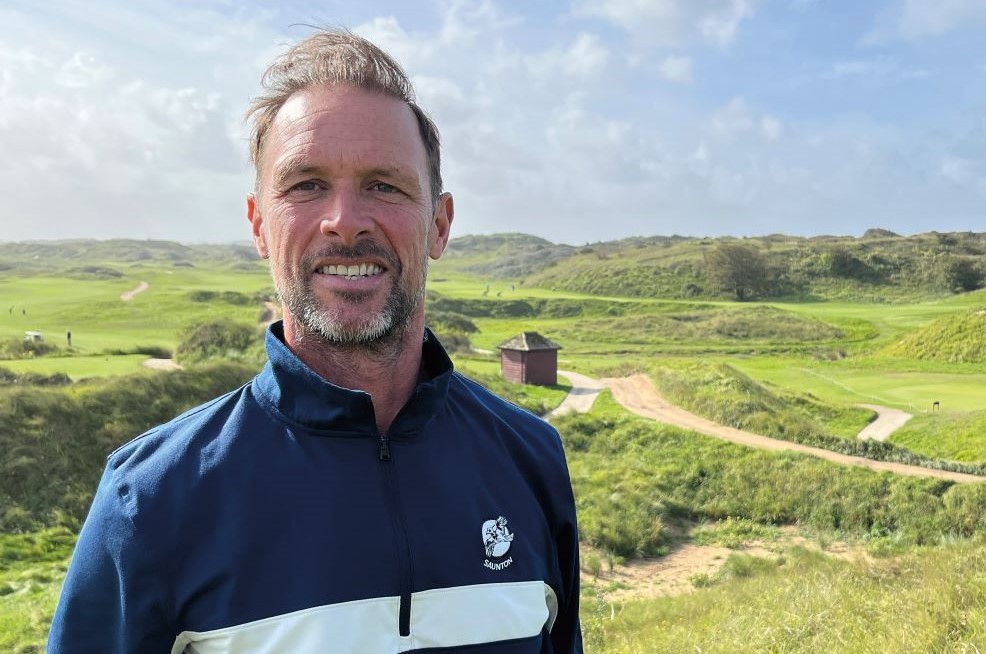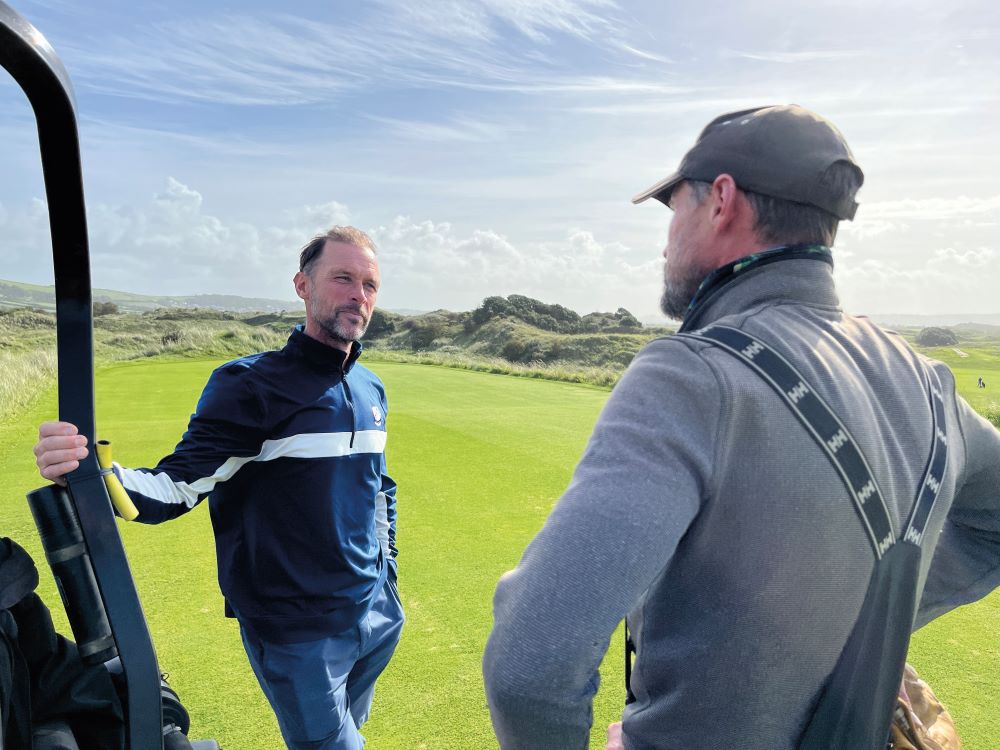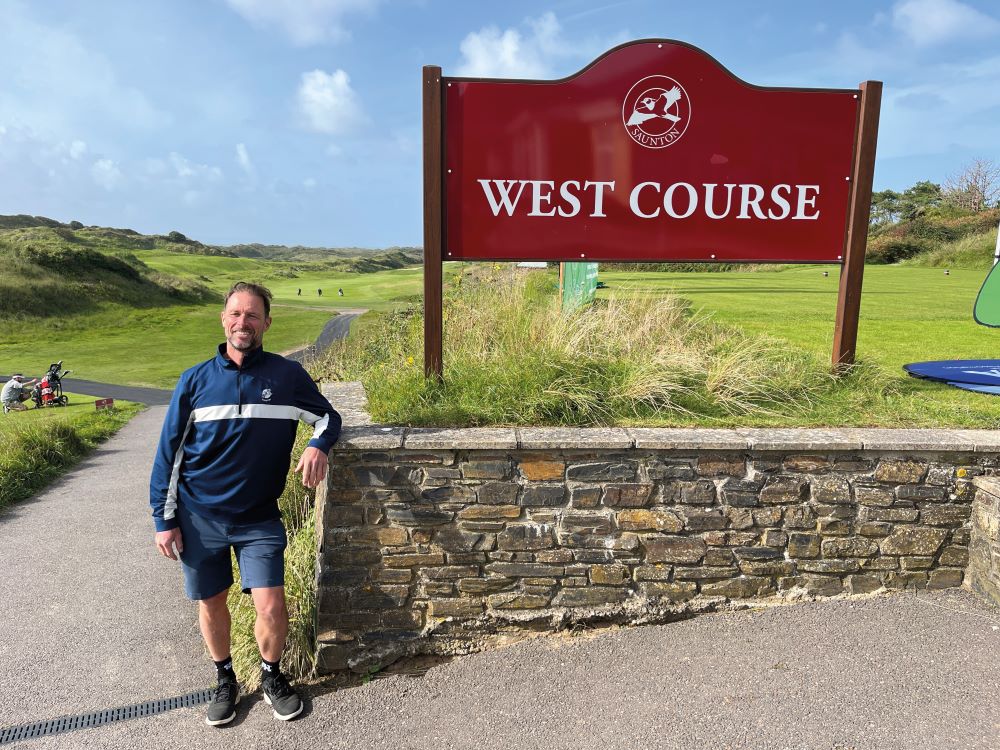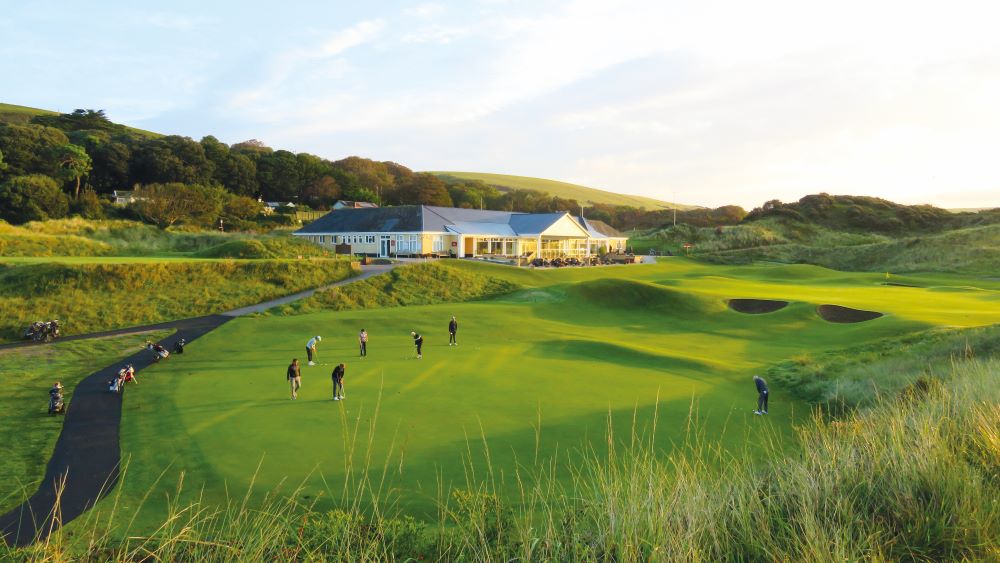- Homepage
- News and Features
- Happiness comes in waves for Saunton’s Murray Long
Happiness comes in waves for Saunton’s Murray Long
A world surfing reserve stretches for almost 20 miles along the coast of North Devon. It is the only one in the UK and one of only 12 worldwide. Stand on the sands at Saunton early in the evening and it’s likely you’ll see Murray Long, course manager at Saunton, trying to catch some waves atop his board.

“It’s the one place that gives me total tranquility,” says Murray. “That’s my escape, my meditation, if you like. Just being in the water in general really has that effect on me. I’ve learned it’s important to take time to relax. You need to find a place where you get that and being in the water, especially on the surfboard, is mine.”
Autumn is considered the best time of year to surf in Devon as strong westerly swells and relatively warm weather and water mean conditions are at their peak. Participants in the BIGGA National Championship during September could hear from across the dunes the constant roar of waves and the Atlantic Ocean clearly has a large role to play in shaping Saunton Golf Club’s rugged West and East courses.
It’s a far cry from Berkshire’s leafy suburbs, where Murray spent much of his career in charge of greenkeeping operations at Sunningdale, but it’s a change he’s relishing.
“That connection to the ocean is definitely a big thing,” says Murray. “It’s different when you get close to London or any big city, but there’s such a lovely community here. In the group I play golf with, there are two or three who surf and it’s a very outdoor place, so everyone is really aware of environmental impact. Living here, you’re with like-minded people who want to do the right things.”
Yet Murray began his career straight from school at Chesham & Ley Hill, a nine-hole venue in Buckinghamshire far from the coast and just outside the M25.
“This is going to sound silly,” he says. “But my granddad absolutely loved his lawn and he would go up and down with a mower, getting the lawn straight. I’d just be sitting there as a little kid and I must have taken something in from that. He never got to see me as a greenkeeper, but that must have had an influence on me.”
After just six months he moved on to Ellesborough, where he worked under Master Greenkeeper Seve Schmitz and David Goodchild, who was deputy and later became course manager. Then came a year’s spell at Berkhamsted, before moving on to Coombe Hill in Kingston upon Thames.

Despite joining as an assistant greenkeeper, by age 24 Murray was head greenkeeper and he spent a decade in charge of the club. During that spell, the team won an award from Golf Monthly for a bunker renovation project and in 2003 Murray became Toro Student Greenkeeper of the Year.
“I was at BTME in 2004 and the Sunningdale job had just come up,” says Murray. “When these big jobs come up, we like to talk about them. Coombe Hill had been brilliant, absolutely fantastic. The course had come on loads, we’d done loads of projects and had great support from members, all the things you are lucky to have as a young course manager. It was brilliant but I thought, well I’ll just go for the Sunningdale job, and I applied on the last day and sent my application while I was at Harrogate.”
During 10 years at Sunningdale, Murray sought to improve the reputation of the New course so it would sit alongside the Old in reputation and standing. Working with the architect Martin Hawtree he undertook woodland and heathland management and redesigned the 18th on the New and 3rd and 10th on the Old. His third child, Charlie, was born in the house at Sunningdale 18 years to the day before Murray hosted BIGGA at Saunton. And yet, childhood holidays on the coast had left a lasting impression that meant he was keen to pursue a quieter pace of life.
“After 10 years I wanted a change and the ocean was calling a little bit,” says Murray. “Sunningdale was great because it opened a lot of doors and you meet lots of people, but I decided I wanted to have more freedom in my working life, so I moved to Poole in Dorset and did seven years of advisory work.”
Advisory – or consultancy – work in the greenkeeping business can be a touchy subject, but Murray says he saw his role as supporting, rather than undermining, the existing greenkeeping team at any venue he worked alongside.
He explains: “I saw it completely as a support mechanism and I would try and make the person feel I wasn’t there to undermine them. My goal was to help them based upon the experience I’d had as a course manager.
“Everyone is different and I never had a prescriptive, ‘This is how you should run a golf course, follow my plan’. Saunton is a different links course to Royal North Devon across the estuary and even though we’re only a couple of miles away, we’re completely different. I’d just try to find common ground with the greenkeepers and find solutions that work for each person and their venue.”
A surfing holiday to North Devon’s beaches in 2020 led to Murray visiting Saunton, where he knew previous course manager Ray Day had retired after 40 years. As the advisory business had expanded, Murray had supported clubs in the recruitment of staff and he thought a visit with general manager Jon Sutherland may bring some business his way.
“We had a good walk round and I really liked Jon,” says Murray. “I thought about it a little while and then suggested to him, what if I do it?”
When applying for the Sunningdale role, over a period of three months Murray was put through numeracy and personality tests, talks with the agronomists and multiple presentations in front of management committees. When it came to landing the Saunton job, the process was a little quicker.
“I was so lucky,” Murray says. “The one thing for me here is that after all those years of looking at it, I thought this place is just a gem. In the same way that when I went to Sunningdale, the New was not regarded anywhere near the Old, but now they’re both level, I see the East and West at Saunton as the same. I just think they’ve got huge potential and that’s why I’m here.”

Saunton Golf Club is entering into a higher tier stewardship agreement with Natural England that will enable the team to remove areas of invasive scrub. This will reveal a hectare’s worth of sand, restoring to life dunes that were previously suffocated by vegetation and adding visual impact to the golf courses.
“The one thing I love about being here is it is really traditional greenkeeping,” says Murray. “The heavier the soil, the more it grows and the more you’ve got to try and cut it, but also the less chance you can actually get out and cut because of the environment and things like rain. It’s really difficult on heavy sites, but when you go to a links you can have a deluge and the greens don’t look anywhere near flooding, because you’re on 20 metres of sand.
“Everyone is trying to create a natural environment, but the more unnatural the land the golf course is built upon and the more you have to select grass species, the more you’re trying to create an artificial environment. We are on a completely natural environment and we try not to do anything that’s unnatural to this area. I just think that’s such a pure form of greenkeeping. I love it.”
However, the natural links setting does present other challenges, such as the prevalence of dollar spot, which is in evidence on various greens approaches. Surrounded by high dunes and hills, cloud can settle across the links and act like a warm, moist greenhouse that incubates dollar spot. Golfers then play the course and transport it to other areas on their shoes, so it quickly becomes rampant.
“We don’t like to spray fungicides,” says Murray. “You’re trying to manage golfer expectations, but we know that if you went out there now, the areas where we have the most dollar spot are the areas that hold the most water. We’ve done extensive work to greens and fairways, but the aprons are high in organic matter and we need to manage those. Once we get to a stage where we’ve reduced that to nothing, we’ll phase down fungicide use. We try and do that with everything to be as sustainable as we can.”

The history of Saunton
Saunton Golf Club was formed in May 1897, originally as a nine-hole course but extended to 18 by 1908. By the early 1920s, following a redesign by Herbert Fowler, the course was gaining a reputation as one of the finest links in England. The second course was added in 1935, again designed by Fowler.
During the Second World War, the area was occupied by the military and used as a training ground ahead of the D-Day landings at Utah and Omaha beach. Evidence of this still exists in the landscape today, with officer’s barracks located where today’s practice putting green is and evidence of tank tracks through the 8th fairway of the West course. Metal detectors have found dog tags and identity bracelets, while further down the Braunton Burrows (as the dunes system that stretches south to the mouth of the River Taw is named) there remain concrete structures that were used as mock landing craft by soldiers to practice storming the beaches of Normandy.
Such a storied history lends itself to marketing, particularly for the American audience who may visit Saunton in their ancestor’s footsteps, and the ambition is that this will work hand in hand with developments out on the course.
Making sustainability a priority
With life in this part of the country so connected to the outdoors, it’s no surprise that sustainability is high on the agenda. Rather than importing sand at £78 a tonne plus transport costs, native aggregates are now used for topdressing and bunkers. Rather than disposing of old revetting from bunkers, these are now screened and reused for things such as divoting. This has contributed to Saunton being recognised as a finalist in the Golf Environment Awards in 2020 and winning both the Green Apple Environment Awards, which the team was invited to accept at the Houses of Parliament, and the Going Green Award at the Community Sport and Recreation Awards.
“For the club, it’s an amazing thing, and for the community to recognise that we’re doing the right thing is amazing,” said Murray. “But as long as I know I’m doing the right job I’m not really worried about awards.”
It’s a pretty laid-back perspective but with a career spent operating at an extraordinarily high level, you get the sense that with Murray Long, and not unlike his beloved North Devon coastline, there’s plenty more going on below the surface than you may spot at first glance. This expertise developed Coombe Hill and even improved Sunningdale’s famous courses - and now it’s reshaping what’s possible at Saunton.
Author

